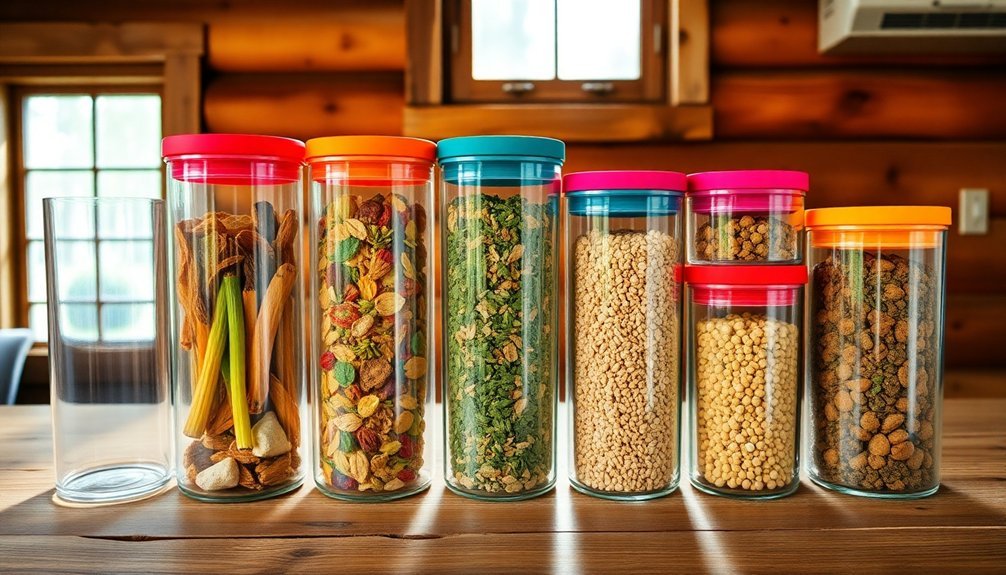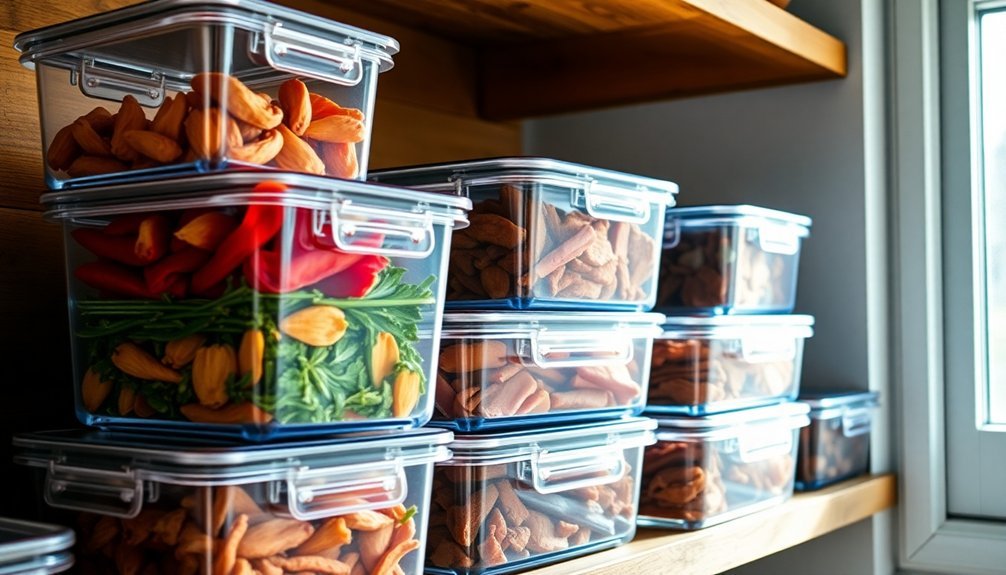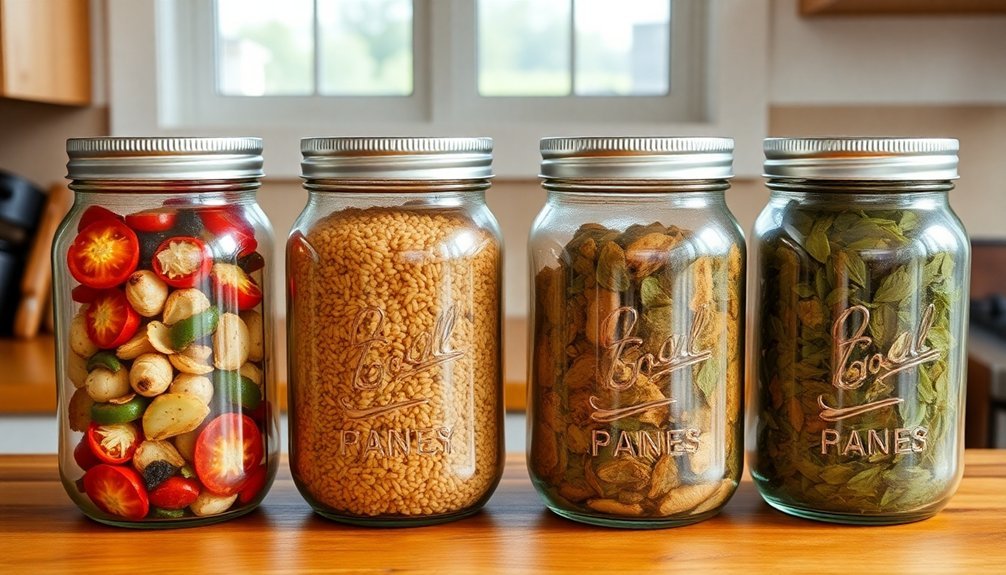Vacuum-sealed containers are your best allies for successful off-grid cooking and food storage. You'll extend food shelf life up to 5 times longer while preventing mold, bacteria growth, and freezer burn. Manual sealing techniques like water displacement or straw methods work perfectly without electricity, making them ideal for outdoor adventures. Keep your containers organized by labeling contents, dates, and rotating seasonal items for maximum efficiency. For solar cooking, choose dark-colored metal or glass containers with tight-fitting lids to optimize heat absorption. The more you understand about proper container selection and sealing methods, the better equipped you'll be for off-grid living.
Essential Off-Grid Container Benefits

When living off the grid, vacuum-sealed containers offer game-changing benefits that'll revolutionize your food storage and preparation methods.
You'll extend your food's shelf life by 3 to 5 times longer than traditional packaging, while preventing mold and bacteria growth. Clean food preparation is crucial, requiring thorough washing before sealing to ensure safety. The containers protect your food from freezer burn and dehydration, ensuring nutrients and flavors stay locked in without additives.
You'll greatly reduce waste by preserving leftovers for weeks, and you can store bulk purchases in smaller portions.
The space-saving design lets you maximize storage efficiency since the containers conform to your food's shape and stack neatly. Plus, you'll find it easier to organize your supplies with clear labeling options.
Whether you're storing in your freezer, fridge, or pantry, these containers maintain food quality while keeping your off-grid kitchen efficient.
Manual Vacuum Sealing Methods
A reliable manual vacuum sealer can be your best friend for off-grid food preservation. When you're away from electrical power sources, you'll need effective manual methods to keep your food fresh and protected. Cost-effective solutions make manual vacuum sealing an economical choice for outdoor adventures.
You can achieve professional-quality sealing using simple techniques that don't require electricity.
- Master the water displacement method by submerging your food bag in water while leaving one corner open – the water pressure naturally forces air out.
- Try the straw technique for dry goods by inserting a straw near the seal, sucking out air, then quickly sealing.
- Use the pressure and zip method by pressing air out with your hands while sealing the bag.
- Double-check your seals and leave about 3 inches of headspace for the most secure preservation.
Food Safety During Storage

Proper food storage practices complement your vacuum sealing efforts to guarantee long-lasting, safe preservation.
You'll need to store perishable foods in your refrigerator between 34°F and 40°F or in your freezer at 0°F or below. When handling vacuum-sealed items, always use clean utensils and work surfaces to prevent contamination.
Be aware that vacuum sealing doesn't prevent all spoilage. Certain foods like raw onions, fresh mushrooms, and garlic shouldn't be vacuum-sealed due to botulism risks. Vacuum sealing creates an anaerobic environment that can allow dangerous bacteria to thrive.
When working with fish, remove it from the packaging before thawing to avoid dangerous bacterial growth.
While dried foods like herbs and grains can be stored at room temperature, you must refrigerate or freeze cooked foods, raw produce, and quick-pickled items after sealing.
Always label your containers with dates and follow recommended storage times.
Space-Saving Container Organization
Organizing vacuum-sealed containers efficiently requires strategic planning and smart space utilization. You'll maximize your storage capacity by implementing vertical solutions and creating designated zones for different food categories. A clear master inventory list helps track all stored ingredients and their locations.
Make sure to leave narrow pathways between container rows for easy access to your preserved ingredients.
For ideal organization in your off-grid storage space:
- Stack compatible containers vertically using sturdy shelving units.
- Label each container with contents, date, and priority level.
- Group similar ingredients together and rotate seasonal items.
- Position frequently used containers at eye level for quick retrieval.
Consider installing wall-mounted racks or overhead storage systems to take advantage of unused vertical space.
When organizing multiple containers, keep your most-used items towards the front while storing long-term preservation items in the back or higher areas.
Solar Cooking Container Compatibility

When selecting containers for solar cooking, specific material and design requirements play a vital role in your success.
You'll want to choose dark-colored metal or glass containers that effectively absorb and conduct heat. Black metal pans are your best option, as they maximize sunlight absorption.
Size matters – opt for small, thin-walled containers with tight-fitting lids to retain heat.
Your container choice should match your solar cooker type: box cookers need vessels that fit inside the insulated space, while panel cookers require containers you can place in heat-resistant plastic bags.
For parabolic cookers, you'll need containers that can handle intense concentrated heat.
Make sure your containers are food-safe and won't release harmful gases when heated.
Adding reflectors and insulation around them can boost their heating efficiency considerably.
Frequently Asked Questions
Can Vacuum-Sealed Containers Withstand Extreme Temperature Changes During Off-Grid Transport?
You'll find that most vacuum-sealed containers handle moderate temperature changes well, but you shouldn't expose them to extreme shifts. It's best to let them reach room temperature before transport to maintain seal integrity.
How Long Do Vacuum Sealer Gaskets Typically Last Before Needing Replacement?
You'll typically need to replace your vacuum sealer gaskets every 12-24 months with regular use, though high-quality ones can last 3-5 years. It's best to check them monthly for wear and tear.
Which Vacuum-Sealed Container Materials Work Best With Campfire Cooking Methods?
You'll find airtight plastic bags work best for campfire cooking. They're heat-resistant, won't melt when boiling, and distribute heat evenly. Place them on a grate or in boiling water for ideal results.
Do Altitude Changes Affect the Seal Integrity of Vacuum-Sealed Containers?
Yes, altitude changes will affect your vacuum-sealed containers' integrity. You'll notice expansion at higher altitudes due to lower atmospheric pressure, which can compromise seals or cause container failure if they're not properly designed.
Can Vacuum-Sealed Containers Be Effectively Cleaned Without Running Water?
Yes, you can effectively clean vacuum-sealed containers without running water by using bottled water, dish soap, and sanitizing solutions. You'll need to scrub thoroughly, rinse well, and guarantee complete drying before reuse.
In Summary
You'll maximize your off-grid cooking success by using vacuum-sealed containers properly. They're essential for preserving ingredients, saving space, and ensuring food safety in challenging conditions. Whether you're using manual sealing methods or preparing meals for solar cooking, these containers protect your food investment. Remember to rotate your stored items and check seals regularly to maintain their effectiveness in your off-grid lifestyle.





Leave a Reply